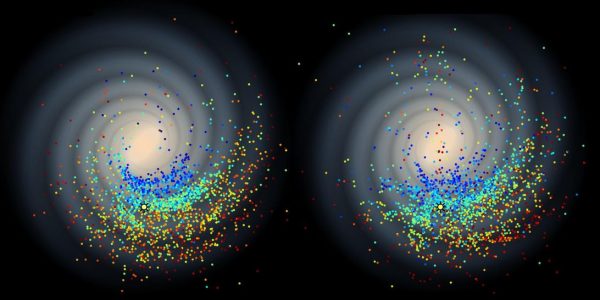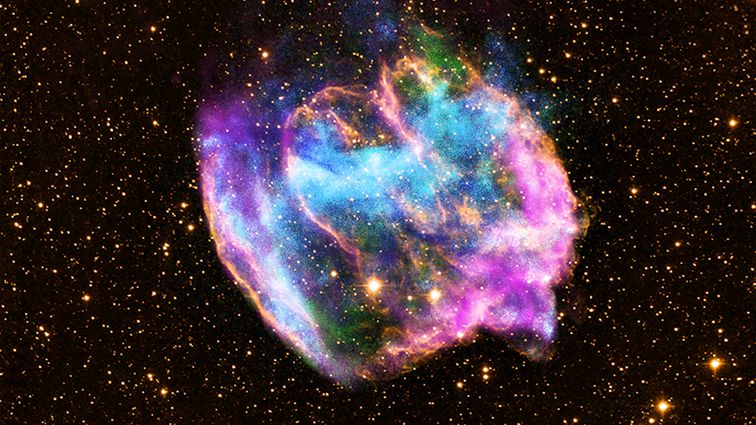Astronomers plot largest 3D scale map of the Milky Way yet – CNET

Top views of the Milky Way show simulated data (left) and the observed positions of the Cepheids.
J. Skowron/OGLE/Astronomical Observatory, University of Warsaw
We don’t have a GPS system for our “warped and twisted” galaxy so astronomers have to get crafty when it comes to pinpointing our location among the stars and creating maps of the Milky Way. We’ve seen epic cosmic cartography before, thanks to the European Space Agency’s Gaia spacecraft. And now astronomers from the US and Europe have put together a new 3D model of the galaxy based on the distance between stars.
Each colored point relates to a star in the Milky Way. The sun is designated by the spiked yellow circle.
J. Skowron/OGLE/Astronomical Observatory, University of Warsaw
The research, published Thursday in the journal Science, draws on a population of stars known as the Cepheids, which are pulsing, massive, young stars that shine brighter than the sun. Using data from the Optical Gravitational Lensing Experiment (OGLE), a sky survey run by the University of Warsaw out of Las Campanas Observatory in Chile, astronomers were able to pick out 2,431 of the Cepheids through the thick gas and dust of the Milky Way and use them to make a map of the galaxy.
Dorota Skowron, lead author on the study and astronomer with Wroclaw University of Science and Technology, says the OGLE project observed the galactic disk of the Milky Way for six years, taking 206,726 images of the sky containing 1,055,030,021 stars. Within, they found the population of Cepheids, which are particularly useful for plotting a map because their brightness fluctuates over time.
This allows scientists to observe how bright the star is in reality versus how bright it looks to us from Earth. The difference between these can tell us how far away a star might be from our sun.
Using that fluctuation, the team produced a 3D model of the galaxy, confirming work that previously demonstrated the galaxy was flared at its edges. They were also able to determine the age of the Cepheid population, with younger stars located closer to the center of the galactic disk and older stars positioned farther away, near the edge.
By simulating star formation in the early Milky Way, the team showed how the galaxy might have evolved over the last 175 million years, with bursts of star formation in the spiral arms resulting in the current distribution of Cepheids ranging from 20 million to 260 million years old.
“We hope that our paper will be a very good starting point for more sophisticated modeling of the Galaxy’s past,” says Skowron. “Our Cepheids are a great testbed for checking the reliability of such models.”
The new research follows a study Nature Astronomy published in February. That study looked at 1,339 Cepheids and created one of the most comprehensive 3D maps of the Milky Way, which showed that our home galaxy is twisted at its edges. It also used a slightly different data set, specifically looking at stars from one of NASA’s telescopes known as the Wide-field Infrared Survey Explorer (WISE).
The two studies show very similar results, particularly in regard to the strange nature of the Milky Way’s warped edges. However, there are still questions about that phenomenon.
Richard de Grijs, an astronomer at Macquarie University and co-author on the Nature Astronomy study, said that both the previous study and the new study rely on Cepheids that sit on our side of the Milky Way.
“A key question would be whether there is a similar, possibly opposite warp [on the other side] too,” he said.
If we could analyze that other side, we’d have a clearer picture of how the Milky Way’s strange warped edges came to be. Was it because of a merger with a smaller galaxy? Or because of gravitational effects? Skowron doesn’t believe that seeing the other side will dramatically increase the number of Cepheids they find. Projects like the European Space Agency’s Gaia, which continues to survey the entire Milky Way, may provide a more concrete answer.
Skowron notes that future projects will look at the older population of stars but also take into account another type of pulsing star found in the galaxy — the RR Lyrae. These elderly stars are from a time much earlier in the Milky Way’s life cycle, so they would provide another method to map the galaxy.

5 Photos
Originally published 11:00 a.m. PT





